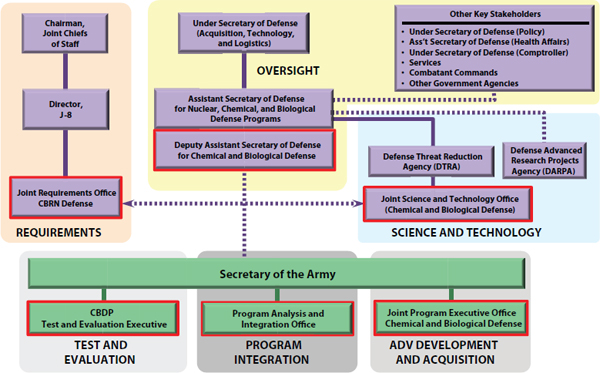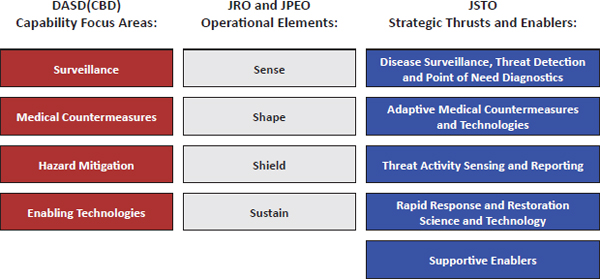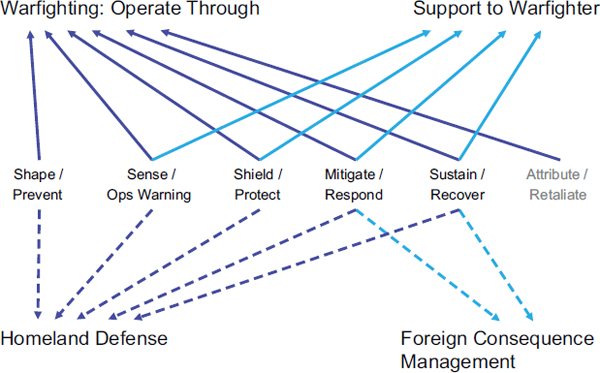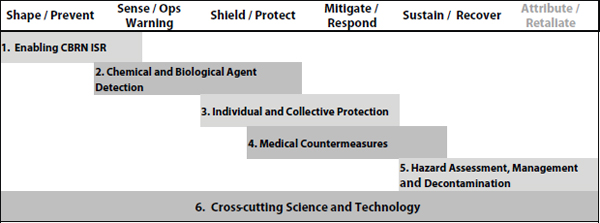The Chemical and Biological Mission Is Broad and the Strategy Is Unclear
CBDP Mission: “Provide global chemical, biological, radiological, and nuclear defense capabilities in support of National Strategies”
A contribution to the persistent problem space, besides the organization, is that the Chemical and Biological Defense Program (CBDP) mission statement is overly broad, allowing wide-ranging interpretation of what is included and, therefore, what is most important. Among the four principle missions are
- Warfighting: Operate Through,
- Homeland Defense,
- Warfighting Support Functions, and
- Consequence Management (Foreign or Domestic).
Among these four missions, priorities vary within each office and with leadership changes each shift priorities in terms of resource allocation and programmatic emphasis.
In the last decade and a half, the CBDP has seen its strategy shift—appropriately in the view of the committee—as leadership has sought a better balance between chemical threats (previously dominant) and
biological threats (of greater concern post 2001 anthrax mailings), and to address the rise of sub- or transnational perpetrators. Accompanying the strategy shift have been changes in investment priorities, but not necessarily in a comparably balanced way. Seeking to have impact quickly, leadership first de-emphasized contamination avoidance in favor of broad-spectrum medical countermeasures. More recently that too has shifted to greater international cooperative public health monitoring and threat reduction. The changes have resulted in rapid ramp-up of investments initially in the Transformational Medical Technologies Initiative (TMTI) in 2005, followed more recently by a decline in TMT funding1 but upticks in biosurveillance and the biological aspects of the Cooperative Threat Reduction program.
While it is difficult to argue against the importance of any of these principle mission areas, all of them demand sustained investments over many years to achieve both fielded capabilities and a robust S&T base to support and advance the state of the art against threats that are not static. Significant variations in funding over three- to four-year cycles are unlikely to yield much progress. For example, the complexities of the development and approval process for a new medical countermeasure require a commitment of approximately eight to ten years. A different set of challenges faces implementation of an international biosurveillance network as it will require that information from many, varied data streams must be carefully integrated in order for analysis to be meaningful.
The committee believes in the wisdom of a defense-in-depth strategy, which balances investments end to end, from pre- to post-event elements. Moreover, sustained investments over appropriate periods of time are required. This approach does not translate to guaranteed funding to performers—they should still be accountable for progress—but it does mean that program decisions come with leadership commitment of continued support as milestones are met on the path to fielded new or improved capabilities.
_______________________
1 The committee heard from several former TMT performers; one possible conclusion is that TMT became a “Big Science” project that outgrew the CBD organizational structure and management culture that was geared toward managing small, independent projects within distinct divisions (e.g., Diagnostics, Medical Countermeasures, etc.). It appears likely that this small-science managerial culture still predominates throughout the Department of Defense (DoD), which has potential implications for the newly growing programs, particularly since their success requires effective managerial coordination across both the JSTO-CBD and the JPEO-CBD.
Organization of the Chemical and Biological Defense Program
History
Prior to the first Gulf War (1991), chemical and biological defense science and techology (S&T) was conducted in the individual Military Services, with the Army being the primary participant (supplemented by limited interest, funding, and execution in the other Services). While the threat was generally known throughout DoD, and perhaps the general public, until the confrontation with Iraq there had never been an imminent chemical and biological (CB) threat. Fortunately, there was no documented use of either a chemical or biological agent by Iraq against US forces. Nonetheless, the perceived lack of adequate protection against chemical and biological agents rose to an unprecedented level of interest, both within DoD and Congress.
Congressional interest resulted in the enactment of PL 103-160 in 1993. This statute consolidated the CBDP into a joint program, with “oversight” at the Office of the Secretary of Defense (OSD). To address the need for Joint Service participation and execution of the program, two groups were established. First, the Joint Service Integration Group (JSIG) was directed to identify Joint requirements and to lead development of a Program Objective Memorandum (POM) that would address the needs of the Services. Second, the Joint Service Materiel Group (JSMG) was created to oversee the research, development, test, and evaluation (RDT&E) functions of the CBDP. The JSMG created the Joint Program Office (JPO) to manage the advanced development aspects of the program. The Army took the lead for creating this office and it essentially reported to the Assistant Secretary of the Army for Research, Development, and Acquisition (ASARDA), thus creating a bifurcated reporting chain. The JPO was originally headed by an Army Colonel (Chemical Corps background), with a civilian deputy. Subsequently, the Joint Program Executive Office for Chemical and Biological Defense (JPEO-CBD), successor to the JPO, was recognized as an Acquisition billet and therefore filled with appropriately trained individuals, while maintaining a senior civilian as the deputy. Both the JSIG and JSMG had flag officer members, and theoretically reported to the OSD to comply with the mandate that OSD be the single focal point within DoD. This somewhat cumbersome management structure remained in place for approximately 10 years. Changes in leadership at various levels resulted in changes in program direction and varying levels of interest, oversight, and advocacy for the program from the OSD.
The second Gulf War in the early 2000’s led to the difficult realization that not much had changed in the CBDP in the preceding decade. Subsequently, a memo from the Under Secretary of Defense for Acquisition, Technology, and Logistics, issued in 2003, created the current program
management structure. In this arrangement, management of the S&T programs was assigned to the JSTO-CBD within the Defense Threat Reduction Agency (DTRA), the advanced development programs continued to be managed by the JPEO-CBD, and the responsibility for establishing the requirements for the CBDP was assigned to a new office within the J-8 of the Joint Staff (the Joint Requirements Office for Chemical, Biological, Radiological, and Nuclear Defense (JRO-CBRND)). This system, represented in Figure 2.1, has created a program management structure which has different reporting chains (i.e., the JSTO-CBD reports to DTRA leadership; the JPEO-CBD reports to ASARDA; and the JRO-CBRND reports to the Joint Staff). Oversight at the OSD level is limited, with the Deputy Assistant Secretary of Defense for Chemical and Biological Defense (DASD(CBD)) having no mandated authority to change program direction, influence the POM and budget, or coordinate individual program/project efforts. This management structure, not surprisingly, is far from effective. Despite claims to the contrary, the committee observed that individual components work independently, with no clear definition of mission and no clear allegiance to program leadership.
The Office of the Assistant Secretary of Defense for Nuclear, Chemical, and Biological Defense Programs/Chemical and Biological Defense (OASD(NCB/CB)), JRO-CBRND, JSTO-CBD, and JPEO-CBD each view the chemical and biological defense mission from a different perspective. Although this is appropriate to some degree, the coordination and collaboration between these groups is far from seamless, which limits their ability to contribute to the mission and vision of the program as a whole.2
- JRO-CBRND views the program in terms of operational elements (i.e., Sense, Shape, Shield, Sustain) and functionalities (e.g., chemical point detection and biological prophylaxis).
- JPEO-CBD views the program in line with the JRO-CBRND operational elements in terms of acquisition and fielding of products (e.g., Joint Chemical Agent Detector, anthrax vaccine).
- JSTO-CBD views the program in terms of S&T capabilities (four thrusts and seven enablers), with the focus on research and early development.
These different views are summarized in Figure 2.2. Overall, there is a lack of clarity within CBDP regarding the full scope of the mission space. Though all parts of the program agree on the dominance of the warfighting mission, there is not necessarily agreement on whether the goal of CBD should be enabling warfighters to “operate through” or if
_______________________
2 See Appendix C for individual framework descriptions.

FIGURE 2.1 Organizational chart of the CBDP enterprise. Solid lines indicate formal line of authority; dotted lines indicate necessary coordination, but no formal lines of authority. The principal program players in the CBDP are highlighted with red borders. The dotted line or no line connectivity among them is factual. No hard-line relationships exist among these offices and the committee observed that indeed each appears to act on its own, with separate organizing constructs as portrayed in the framework comparison of Figure 2.2. There is, in fact, no program-wide chemical and biological defense strategy, or common characterization of the program elements.

FIGURE 2.2 Chart comparing the high-level frameworks, primary CBDP enterprise elements.
it is achieving zero casualties after exposure to CB threats. In addition, these different missions mean that many parts of the organizations do not share a common understanding of what priority should be placed on the support missions (either for the warfighter or to civil authorities). All of this is concerning for both CBDP’s development and acquisition functions because ambiguity about mission priorities could lead to overspecified, underspecified, and/or unspecified requirements, or worse, no fielded capability.
Taking into consideration the multiple perspectives of the CBDP offices, the committee found that it needed both common definitions and a common framework in order to determine the core S&T capabilities that are required for the CBDP.
The committee agreed on a series of definitions to discuss the CBDP capabilities. The chemical and biological defense enterprise is encouraged to maintain a well-defined set of terms for use in the CBDP enterprise. The working definitions for this report are:
- CBD operational capability: Ability to assure success of the military mission by avoiding or operating in/through a chemically or biologically contaminated environment.
- S&T capability: RDT&E capacity and RDT&E competency to enable development, improvement, and/or innovation of a CBD operational capability.
- RDT&E capacity: Resources (e.g., equipment, facilities, people, plans, funds, etc.) that enable a capability.
- RDT&E competency: Quality at which a function or service can be provided, as recognized by outside experts.
- Core (adj.): Essential to ensuring the capability.
Using these definitions, the committee began to think about a framework for the development and discussion of Core S&T Capabilities for the CBDP. Taking advantage of the Joint Requirement Office’s Chemical, Biological, Radiological, and Nuclear (CBRN) Defense Operational Elements3 (Shape, Sense, Shield, Sustain) and the CBDP Strategic Framework Constructs from the office of the DASD(CBD)4 (Prevent, Protect, Mitigate, Respond, Recover), the committee mapped these elements to the four overarching missions as described in Figure 2.3.

FIGURE 2.3 Overview chart of the relationship between the four mission areas of CBDP and the program’s six operational elements.
_______________________
3 Modernization Plan for Chemical, Biological, Radiological and Nuclear (CBRN) Defense, Joint Requirements Office for CBRN Defense, January 5, 2012.
4 Chemical and Biological Defense Program (CBDP) Strategic Framework and Department of Defense (DoD) Organization, Dr. Robert Cohn, Chief Scientist, Office of the Assistant Secretary of Defense for Nuclear, Chemical and Biological Defense Programs/Chemical and Biological Defense, February 15, 2012.

FIGURE 2.4 Chart depicting the relationship between the six CBDP Operational Elements and the six CBD S&T capability categories.
Once the appropriate correlations between the CBD Operational Elements and the missions of the CBD program were identified, they were used by the committee to identify S&T capability categories required to address both the missions and the defined operational elements. The six committee-identified CBD S&T capability categories can be discussed based on their mapping to the “time oriented” operational elements. A listing and mapping of the CBD S&T capability categories is found in Figure 2.4.
The CBDP is of such broad scope that it has a role to play in all stages of chemical and biological defense. While the CBDP is not a direct actor in intelligence, surveillance, and reconnaissance (ISR), the program plays a role in the development of ISR S&T tools. To this end, the committee identified (1) Enabling CBRN Intelligence, Surveillance, and Reconnaissance as one of the core S&T capability categories. The program plays a greater role in (2) Chemical and Biological Agent Detection which supports Sense/Operational Warning and Shield/Protect operational elements. The operational element Shield/Protect, coupled with Mitigate/Respond supports the (3) Individual and Collective Protection S&T capability. (4) Medical Countermeasures falls under Shield/Protect, Mitigate/Respond, and Sustain/Recover, while (5) Hazard Assessment, Management, and Decontamination is supported by overlapping Sustain/Recover with Attribute/Retaliate, an operational element that is only on the edges of the purview of the CBDP. Finally the committee identified several S&T capabilities that are core to all of the identified operational elements. These capabilities are covered in (6) Cross-Cutting Science and Technology.
As stated previously, the committee found many operational frameworks present within the units of the CBDP enterprise. Each unit views the problem through its own lens. With the framework for viewing the core S&T capabilities in hand, the disparate frameworks of OASD(NCB/CB),
JRO-CBRND, JSTO-CBD, and JPEO-CBD fit under the six S&T capability categories defined by the committee (see Appendix D for a chart comparing the S&T capability frameworks of the CBDP enterprise elements in relationship to the committee’s six CBD S&T capability categories).
The next chapter will expand on the S&T capability categories, identify the core S&T capabilities that are need to be maintained by the CBDP, and consider where the capabilities may be obtained.
In Chapter 2 the committee identified the following findings and recommendations:
Mission and Strategy
Finding 2.1: The CBDP mission is too broadly stated. The stated mission of CBDP is to “Provide global chemical, biological, radiological, and nuclear defense capabilities in support of National Strategies.” The mission statement is large enough to allow for a wide variety of interpretations, making it challenging for both the customers of the program and the facilities that support its work to understand the program priorities.
The CBDP has responsibilities that span missions from protecting the warfighter and providing support to the warfighter, to defending the United States from attack (i.e., Homeland Defense) and supporting local authorities following a chemically or biologically related incident (i.e., Consequence Management, Foreign or Domestic). Events requiring the Department to perform each of these missions could unfold in innumerable, unexpected ways; for example,
- naturally occurring disease or unintentional chemical exposures may be difficult to distinguish from intentional attacks;
- intelligence, as noted above, has historically proved uncertain and/or unreliable in assessing the CB threat;
- innovations, as witnessed in the case of improvised explosive devices, will certainly occur in the development and use of chemical and biological weapons; and
- the United States has a poor understanding of the intentions of those who might use chemical and biological weapons, and an even poorer understanding of the barriers that prevent them from doing so.
The combination of a broadly stated mission and numerous uncertainties calls for top-level guidance on focus and priorities, which the current program lacks.
Finding 2.2: There is no program-wide CB defense strategy, nor common characterization of the program elements among the participating organizations. The many different organizations currently involved in the CBDP (e.g., OASD(NCB/CB), JRO-CBRND, JSTO-CBD, and JPEO-CBD) each view the chemical and biological defense mission from different perspectives. Although this can be expected based on their different roles, the coordination and collaboration between these groups is far from seamless. As a result, the program has been—and continues to be—limited in its ability to deliver fielded solutions in a timely manner.
Finding 2.3: Strategic priorities tend to change with changes in senior leadership. As a result, efforts requiring sustained and/or longer-term commitments (e.g., medical countermeasures) are unable to deliver timely results, if at all.
Recommendation 2.1: The DASD(CBD) should lead a mission and strategy development activity that aligns all of the program elements and offices. The differences among offices in how they portray and communicate their stories, in their priorities, and in the terminology they use to describe the program are stark. Bold moves are needed to break the current stagnation that permeates the chemical and biological S&T and acquisition environment. Tweaking the management or refocusing a few projects will not be sufficient. The recommended alignment activity should promote a shared understanding of and commitment to key priorities for maintaining the core capabilities and expertise needed to fulfill the overall program mission and strategy.










